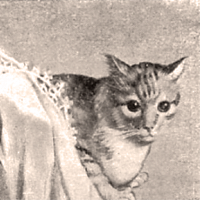When
Elena at
Italian Needlecrafts got some no. 5
Coats Cucirini (Anchor) multi-coloured Pearl Cotton thread I immediately wanted some (my inner thread addict reared its ugly head). I was thinking of making tassels because no. 5 Pearl Cotton is so nice for that - even better no. 3 Pearl Cotton but that has become
very hard to find. I ordered 4 skeins thinking that I'd make 4 small simple tassels for the corners of a tablerunner.
I chose colour no. 1385 which is brown/gold/cream but it was a tough choice. I really wanted no. 1355 (green/yellow/blue) too.

The skeins arrived quickly and I leafed through
Nappe e Pendagli by
Giuseppa Federici for something simple - I love this book! I found a tassel I liked right away and went hunting for a wooden bead for the head. Some years ago there was a HUGE crafts store near here and when they closed down I bought all kinds of things that I "might use later"... so I already had several sizes of wooden beads at home. I picked a 7/8" one and made a wrap around a pencil with a single thread to get started.
The pattern called for 10
Punto Avorio stitches around the pencil. (While
Punto Avorio is used in
Puncetto, it is also used in several different Italian needlework techniques.)
Now, here's where I didn't think ahead. The pattern in the book was made with
Cotone Povero which is an undyed cotton yarn a little thicker than kitchen string. It is almost twice the thickness of Pearl Cotton no. 5. The pattern said I wouldn't need to increase the number of
Punto Avorio stitches from 10 as the thread would stretch around the wooden bead. Great! I forged ahead.
After making 10
Punto Avorio stitches around the pencil loop, I slipped the loop off the pencil and held it on top of the bead to continue. This is a little tricky to do - you need a third hand to hold it all steady, so I dropped my bead enough times to work up a sweat in frustration.
By the sixth row I was really liking how it was looking:

A couple of rows later however the stitches were really opening up and you could see the wooden bead. I decided I didn't mind it so I didn't increase the number of
Punto Avorio stitches. At the bottom I just ran my thread end under the tighter fitting rows of stitches to hide it.
I got out my trusty
Kreinik Custom Cord Maker and wound four lengths of thread into a cord. Knotting the cord every centimetre I managed to get about 7 or 8 little pieces like the ones
here. This time I was a little better at measuring one centimetre!
The pattern called for ten tendrils with varying numbers of knotted pieces tied to them. I made a few cords, knotted them and cut them into little pieces. After attaching a few tendrils I decided that I'd better use another skein of thread for more pieces because I wasn't anywhere near having enough - my tassel looked quite sad and its head was too big.
More cording, knotting, cutting... hmmm. Not enough - another skein! Cord, knot, cut.... uh oh! I certainly was beyond my original idea of doing four simple tassels. My tassel still looked skimpy and I only had one skein of thread left. What to do? There was no going back now! I used up the rest of my last skein except a little bit for making a top loop to hang the tassel from. It was getting a bit heavy and the stitches around the wooden bead stretch quite a bit. In retrospect I think I should have increased the number of
Punto Avorio stitches at least for the 7 or 8 rows around the widest part of the bead:

I really love the way it looks: nice and full. The multicoloured Pearl Cotton is perfect for making an interesting tassel. Each little piece has a knot before and after to keep it in place on the tendril length and then between some of the pieces are one, two or three knots just to give varying length. I did end up with ten tendrils. Some have only seven knotted pieces on them and some have as many as 20. Each tendril is different which creates a lovely effect!

Now (darn!) I must order more thread.
:-D
Maybe I'll get some of that other colour too...
Nappe e Pendagli is available from
Tombolo Disegni (click on Libri/Books, then Libri/Ricamo, then Ricamo Italiani - send an email request to order).























































